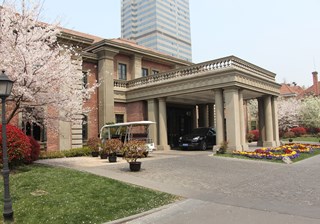- +86-13267351235
- info@globalstourtravels.com
With its thick iron railings and dark colors the Rui Jin Guest House is a distinctive place.  Tall trees and a diverse collection of flowers can be found within the hotel wall. Stepping through the wide entrance, you will immediately look upon the businessman, H.E. Morris.
Tall trees and a diverse collection of flowers can be found within the hotel wall. Stepping through the wide entrance, you will immediately look upon the businessman, H.E. Morris.
Morris was one of the first western explorers to come to the Far East, arriving in Shanghai in 1867. An inveterate gambler, Morris loved to bet on horse races. Luckily for Morris, he was blessed with excellent luck and ended up winning a fortune at the race track. With his newfound wealth, Morris invested in real estate, buying up imposing courtyard and the grand refined western style buildings in the garden. This venerable old garden hotel was once the most eminent and reputed private residence of 1930's and 1940's era Shanghai. Built in the 1930's, the most storied sections are without a doubt buildings number one and number two. Chiang Kaishek and Song Meiling were once frequent guests here as were Zhou Enlai, Chen Yi, and Lin Biao. The five villas, each with its own style, are all built in the European fashion, and create an extremely comfortable living environment. The man who was responsible for these fantastic buildings was none other than the legendary British explorer and land and building houses for rent, and he eventually bought into Shanghai's North China Daily News newspaper. Many of the homes in Shanghai's alleyways begin their names with the Chinese character, "ma". Short for Morris, this is a sign the British explorer was involved in the house's construction or sale.
Rui Jin Guest House's number one building was originally meant to be a residence built exclusively for Morris. However, when construction was completed, Morris decided he did not want to live here. Supposedly, he did not particularly care for the building's lighting and colors, feeling that they were to dark. Not long after the building was finished, Morris sold it and began working on new house nearby. Morris's new house would eventually become Rui Jin Guest House's building number three. The design of this new building was, as expected, different from the first. Mounting materials incorporated marble, copper and glass, and the color, scheme was much brighter as a result.
In 1945, Morris's house was incorporated into part of the Kuomintang headquarters, and Song Meiling was frequently seen coming and going from this building. A rumor at the time stated that Huang Jinrong had purchased the building for Song Meiling as a birthday present.
After the founding of the People's Republic, buildings one through four were united (they were originally independent homes) to form the National Hotel which was used exclusively to receive foreign heads of state and VIP guests.
Rui Jin Guest House is excellently preserved, and has been utilized as a setting in many Chinese films such as Chen Kaige's Temptress Moon (and Man Kit Poon's Shanghai Grand. As it is portrayed on film, Rui Jin Guest House is really one of the most beautiful old structures in Shanghai.
Rui Jin Guest House sits on the atmospheric Rui Jin Er Lu. When you walk down this road, tall Chinese parasol trees will restrict your line of vision with their long branches. Both sides of the road are densely packed with stores, which have turned Rui Jin Er Lu into a small bustling commercial road. Loaded with authentic modem Shanghai tones, if you arrive in the evening, Rui Jin Er Lu will allow you to deeply experience Shanghai's unique charm.
If you decide to stay at Rui Jin Guest House, stay in one of the deluxe double bedrooms. The rates are 990 RMB a night and you need to book in advance. Telephone: 021-64725222. Before you book a room, be sure to ask if the hotel is running any discount rates.
Address
Rui Jin Guest House is located on 118 Rui Jin Er Lu. It is a fiveminute walk from Huaihai Lu and a ten minute walk from the Huangpi Lu subway station. Traveling by bus, you can take lines 14,24,42,96, the 146 Loop Line, the 401 Southern Line, 786, and 304 to the Huangjiner Lu or the Rui Jin Hospital bus stop.